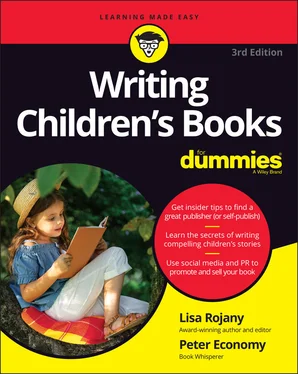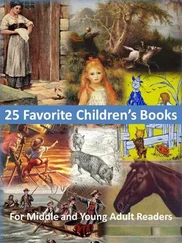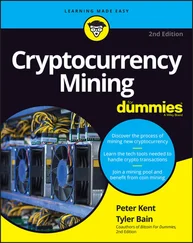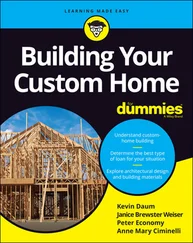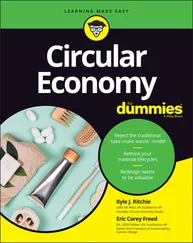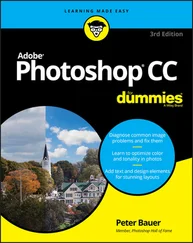Peter Economy - Writing Children's Books For Dummies
Здесь есть возможность читать онлайн «Peter Economy - Writing Children's Books For Dummies» — ознакомительный отрывок электронной книги совершенно бесплатно, а после прочтения отрывка купить полную версию. В некоторых случаях можно слушать аудио, скачать через торрент в формате fb2 и присутствует краткое содержание. Жанр: unrecognised, на английском языке. Описание произведения, (предисловие) а так же отзывы посетителей доступны на портале библиотеки ЛибКат.
- Название:Writing Children's Books For Dummies
- Автор:
- Жанр:
- Год:неизвестен
- ISBN:нет данных
- Рейтинг книги:4 / 5. Голосов: 1
-
Избранное:Добавить в избранное
- Отзывы:
-
Ваша оценка:
- 80
- 1
- 2
- 3
- 4
- 5
Writing Children's Books For Dummies: краткое содержание, описание и аннотация
Предлагаем к чтению аннотацию, описание, краткое содержание или предисловие (зависит от того, что написал сам автор книги «Writing Children's Books For Dummies»). Если вы не нашли необходимую информацию о книге — напишите в комментариях, мы постараемся отыскать её.
Writing Children’s Books For Dummies,
For Dummies
Writing Children’s Books For Dummies
Writing Children's Books For Dummies — читать онлайн ознакомительный отрывок
Ниже представлен текст книги, разбитый по страницам. Система сохранения места последней прочитанной страницы, позволяет с удобством читать онлайн бесплатно книгу «Writing Children's Books For Dummies», без необходимости каждый раз заново искать на чём Вы остановились. Поставьте закладку, и сможете в любой момент перейти на страницу, на которой закончили чтение.
Интервал:
Закладка:
 The best action/adventure stories include engaging, well-thought-out plots and a main character who’s smart, self-reliant, and cunning. These stories have a true danger element and often take place in territory unfamiliar to the reader.
The best action/adventure stories include engaging, well-thought-out plots and a main character who’s smart, self-reliant, and cunning. These stories have a true danger element and often take place in territory unfamiliar to the reader.
Subgenres of action/adventure include thrillers and espionage (usually involving a spy who must protect their imperiled country, school, or family against an enemy), mysteries, crime-solving stories, and detective novels.
True stories
Who needs to make up a story when you can find so many true stories out there simply waiting for you to transform them into a children’s book? (See examples of true stories in Figure 3-3.)
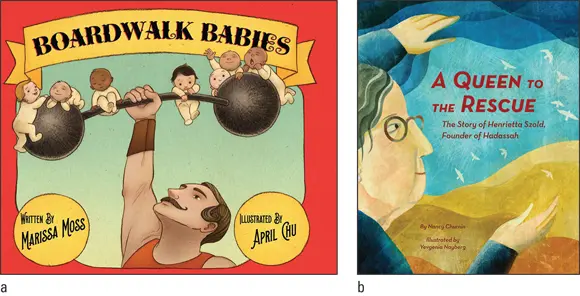
a) Boardwalk Babies. Text copyright © 2021, Marissa Moss. Illustrations copyright © 2021 April Chu. Reprinted by permission. b) A Queen to the Rescue. Text copyright © 2021 Nancy Churnin. Illustrations copyright © 2021 Yevgenia Nayberg. Reprinted by permission.
FIGURE 3-3:Example true stories.
One real-life subject that all children seem to gravitate toward is true stories about animals. One successful example is Owen & Mzee: The True Story of a Remarkable Friendship, by Isabella Hatkoff and Craig Hatkoff (Scholastic Press), about a baby hippo and a 130-year-old giant tortoise who adopt each other after a tragedy leaves the baby hippo orphaned.
If you narrow down the category of animals to dogs, cats, and other domesticated beasts (who have a lot in common with children, after all), you have another potentially winning formula. A moving example is Marshall the Miracle Dog, written by Cynthia Willenbrock and illustrated by Lauren Heimbaugh (The Marshal Movement), which relates the story of a horribly mistreated and disfigured dog who, against the odds, finds a loving forever home.
Many new writers swear they have an incredible tale, stranger than fiction and 12 times more lovely. Great! Go ahead and write it. Just beware that all the rules of writing good children’s books apply to real stories just as much as they do to fictional ones.
Historical fiction
Who needs to look further than history to find exciting stories of heroes and heroines from all over the globe? Based on real events or on real people in history, historical fiction offers the best of both worlds if you write it well: exciting stories and stealthy learning. You can create great historical fiction as picture books, chapter books, middle-grade books, YA novels, and graphic novels.
My America (Scholastic), written by a variety of authors, is a successful middle-grade series in this category; see also Lyddie, by Katherine Patterson (Puffin Books). YA has seen an explosion of writing in this genre, including A Great and Terrible Beauty (Ember) and The Diviners (Little, Brown), both by Libba Bray. For more YA historical fiction, consider We Are Not Free, by Traci Chee (Clarion Books); These Violent Delights, by Chloe Gong (Margaret K. McElderry Books); and The Enigma Game, by Elizabeth Wein (Little, Brown Books for Young Readers). Teachers, librarians, parents, and children clamor for the subject matter that these well-written books cover.
Historical fiction provides the perfect genre for writing about real people that the school history books tend to overlook, such as British-Jamaican nurse and businesswoman Mary Seacole (see Figure 3-4). Historical fiction can involve presenting real characters not commonly known because of issues of race or gender, looking at the past through a new lens of diversity, or refashioning issues currently in the cultural spotlight.
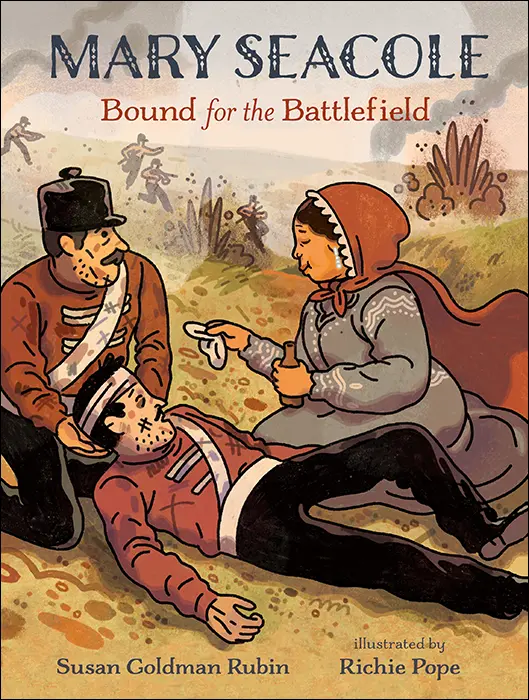
Mary Seacole: Bound for the Battlefield. Text copyright © 2020 by Susan Goldman Rubin. Illustrations copyright © 2020 by Richie Pope. Reproduced by permission of the publisher, Candlewick Press, Somerville, MA.
FIGURE 3-4: Mary Seacole: Bound for the Battlefield, an example of historical fiction .
 To write good historical fiction, keep in mind that the time and place provide the setting for the story, but the plot and characters are still the most important elements. Don’t let the setting or time period take center stage. And remember that the characters live in the time in which the story is set, so they don’t remark on how different the setting is from our time period or even notice what we’d consider strange or different.
To write good historical fiction, keep in mind that the time and place provide the setting for the story, but the plot and characters are still the most important elements. Don’t let the setting or time period take center stage. And remember that the characters live in the time in which the story is set, so they don’t remark on how different the setting is from our time period or even notice what we’d consider strange or different.
Mysteries
Good mysteries for children have been around for a long time. Children, like adults, love to piece together clues in a story to guess the outcome — or get creeped out trying to. Mysteries are here to stay, from the Nancy Drew series, by Carolyn Keene, and the Hardy Boys series, by Franklin W. Dixon, which offer mysteries for middle graders to solve, to the Magic Tree House series, by Mary Pope Osborne, whose protagonists solve mysteries of science and the universe. Figure 3-5 features a recently published mystery.

From The Einsteins of Vista Point, by Ben Guterson, © 2022. Reprinted by permission of Christy Ottaviano Books, an imprint of Hachette Book Group, Inc.
FIGURE 3-5: The Einsteins of Vista Point, a recent addition to the mystery genre .
In this genre, a few conventions help authors build intriguing characters and riveting mysteries:
The beginning: The story starts with the commission of a crime (even murder in YA and adult books).
The plot: A mystery novel should solve a puzzle and create a feeling of resolution for the reader. The main plot (more on plot in Chapter 9) deals with a mystery that needs solving.
The central character: The detective or other fact-finder. The rest of the characters are usually suspects at one time or another. In the best mysteries, the central character is a quirky, humorous, offbeat, or unusual person — easy to remember and build a series upon.
Suspense: The genre uses suspense to keep the reader turning the pages.
Danger: The detective often faces danger at some point.
Foreshadowing: The author heightens dramatic tension by using foreshadowing, hinting at events to come or suspects’ motives.
The MacGuffin: A mystery always has twists and turns, and sometimes a MacGuffin or two. A MacGuffin is an object, event, or device that furthers the plot and motivation of the characters, but it’s irrelevant or insignificant in itself. The name was originated by Angus MacPhail, the screenwriter for a film directed by Alfred Hitchcock, king of film mysteries.
Solving the mystery: In the end, the protagonist always comes out on top, having solved the mystery.
Good mysteries, those that have a real plot and believable characters, start appearing in early chapter book series. Some mainstays are The Genius Files series, by Dan Gutman (HarperCollins), which features the McDonald twins, Coke and Pepsi, who solve mysteries; the Brixton Brothers series by Mac Barnett (Simon & Schuster Books for Young Readers), about a boy who ends up becoming the best detective by taking his cue from literary sleuths; and the Nancy Drew Diaries , by Carolyn Keene (Aladdin), in which Nancy Drew and her friends Bess and George tackle everything from sabotage to kidnapping. You can also find plenty of stand-alone titles for this age group.
Читать дальшеИнтервал:
Закладка:
Похожие книги на «Writing Children's Books For Dummies»
Представляем Вашему вниманию похожие книги на «Writing Children's Books For Dummies» списком для выбора. Мы отобрали схожую по названию и смыслу литературу в надежде предоставить читателям больше вариантов отыскать новые, интересные, ещё непрочитанные произведения.
Обсуждение, отзывы о книге «Writing Children's Books For Dummies» и просто собственные мнения читателей. Оставьте ваши комментарии, напишите, что Вы думаете о произведении, его смысле или главных героях. Укажите что конкретно понравилось, а что нет, и почему Вы так считаете.
